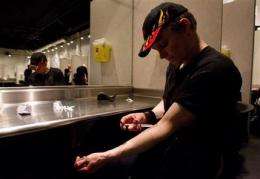In an April 18, 2011 photo, Nicole Henry injects morphine he bought on the street at the Insite safe injection clinic in Vancouver, B.C. Insite, North America's first and only legal injection site, promoted by its founders as a safe, humane facility for drug abusers, is now facing a court challenge from a government that sees it as a facilitator of drug abuse. The case opens before the Supreme Court of Canada in Ottawa on Thursday, May 12, 2011 and has drawn international attention. (AP Photo/The Canadian Press, Darryl Dyck)
(AP) -- The woman stands close to a mirror fingering her throat. Then, sweeping back a mane of red hair, she injects heroin into her jugular vein. A nurse keeps an eye on her from behind.
The scene unfolds in North America's first and only legal injection site, promoted by its founders as a safe, humane facility for drug abusers, now facing a court challenge from a government that sees it as a facilitator of drug abuse.
Defenders of the taxpayer-funded site, in a seedy, drug-infested district of Vancouver, British Columbia, say it is a providing a form of health care, and that health care is a provincial matter under Canada's constitution. The federal government counters that its writ trumps provincial rights because heroin is a federally banned substance.
The case opens before the Supreme Court of Canada in Ottawa on Thursday, and has drawn international attention. As of 2009, there were 65 injection facilities in 27 cities in Canada, Australia, and western Europe, according to the Canadian Medical Association Journal. The World Health Organization has called them a "priority intervention" in slowing the spread of AIDS via infected needles.
Insite, as the Vancouver center is called, receives more than 800 visitors a day on average and has supervised more than a million injections since it opened in 2003, and none has caused a death, according to Insite supervisor Russ Maynard.
Addicts are given clean needles and sterilized water in which to mix their drug. They bring their own drugs and inject at 12 stainless steel alcoves with mirrors on the walls so nurses on a raised platform can see them.
The storefront facility sits in Downtown Eastside, 15 blocks of cheap rooming houses where addiction and street prostitution are rampant and an estimated 5,000 of the area's 12,000 population are believed to be addicts.
When Insite opened, the Bush administration's drug czar, John Walters, called it "state-sponsored suicide," and after a Conservative government was elected in Canada in 2006, it moved to close the site.
Arguing for the government before the British Columbia Court of Appeal in 2009, Robert Frater rejected the notion that Insite was a form of health care, because it was not the ban on drugs that harms addicts.
"There is no constitutional obligation on the state to provide safe-injection rooms," he said.
The provincial court ruled 2-1 against the federal government.
Supporters of Insite point to studies showing sharp drops in deaths from drug overdoses in the district since the drug-injection program was launched.
"I think it's saying we're effective. We're meeting our mandate," Maynard said. He said Vancouver also needs a safe-inhalation facility for crack users, while Ontario and Quebec need safe-injection sites like Vancouver's.
Julio Montaner, president of the International AIDS Society, an association of professionals in the AIDS field, has said the area's AIDS rate is the worst in the developed world, and can be designated an epidemic. Montaner, a Canadian, accuses his government of ignoring scientific research and sabotaging a health initiative for society's weakest citizens.
In 2008 the then federal health minister, Tony Clement, told the Canadian Medical Association that the Conservative government opposed Insite because "injections are not medicine and they do not heal."
Dr. Bonnie Cham, then head of the CMA's ethics committee, responded that addicts who inject drugs "have the right to compassion and access to care that has proven to be beneficial."
Last week the Conservative Party was elected to another term.
©2011 The Associated Press. All rights reserved. This material may not be published, broadcast, rewritten or redistributed.


















